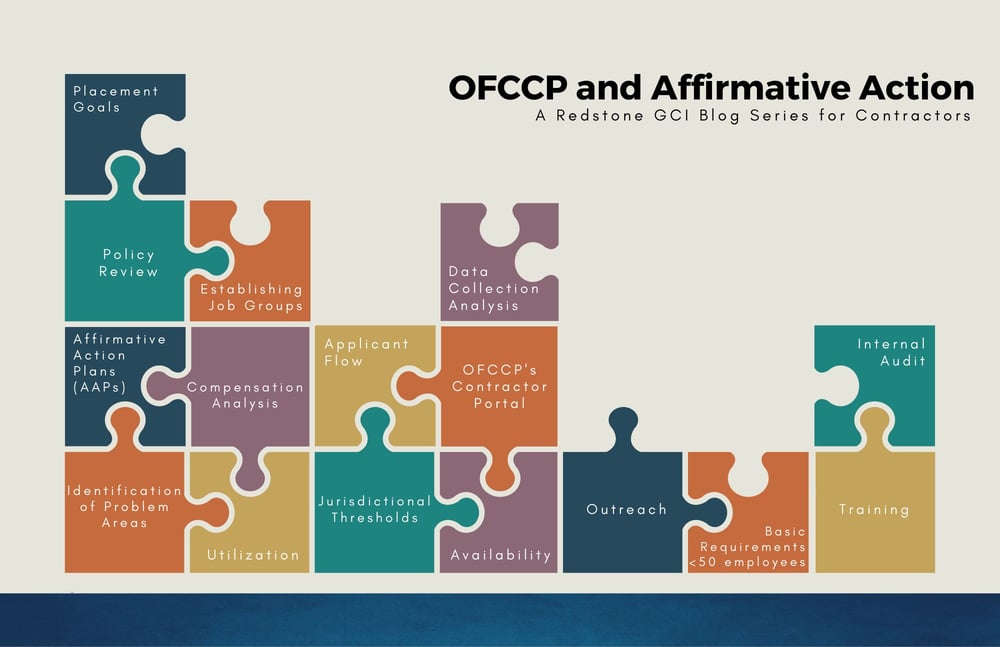
This article is under review as a result of EO 14173, Ending Illegal Discrimination and Restoring Merit-Based Opportunity, signed by President Trump on January 21, 2025. As we await further information from OFCCP and the courts, please reference this article for current status and action items.
Throughout this series, we’ve explored the fundamentals of compliance with the regulations administered by the Office of Federal Contractor Compliance Programs (OFCCP) and many of the components of a written Affirmative Action Plan. In this final blog of the series, we will answer a question frequently asked of us…What do you do with all this information?
This is an excellent question! The regulations instruct contractors to Identify Problem Areas[1] by performing “in-depth analyses of its total employment process to determine whether and where impediments to equal employment opportunity exist.” This chart provides the minimum evaluation criteria set forth in the regulations along with some practical thoughts and action items. Note that though these regulations are specifically applicable to EO 11246, the requirements are much the same for Section 503 and VEVRAA.
Minimum Evaluation Requirements and Practical Thoughts and Actions Items
- The workforce by organizational unit and job group to determine whether there are problems of minority or female utilization (i.e., employment in the unit or group), or of minority or female distribution (i.e., placement in the different jobs within the unit or group);
Generally, this process will compare the utilization of women and minorities in your current workforce to the availability of women and minorities for each Job Group, thus determining if Placement Goals are needed for each Job Group. A Placement Goal is expressed as a percentage and is required when underutilization is detected. Ensure you’re considering the following:
- Appropriate census codes for your employees
- Geographic areas which accurately reflect the reasonable recruitment area for each job group
Consideration of the correct census data (Effective January 1, 2022, OFCCP required the use of the 2014-2018 American Community Survey Census Data)
- Personnel activity (applicant flow, hires, terminations, promotions, and other personnel actions) to determine whether there are selection disparities;
Recall all those records you’ve been maintaining? It’s time to gather that information for the 12 months prior to the plan effective date and perform analyses on each Job Group to determine if adverse impact is indicated.
- Compensation system(s) to determine whether there are gender-, race-, or ethnicity-based disparities;
Pay equity is at the forefront of OFCCP’s focus and will without a doubt be assessed if under audit by OFCCP. The audit landscape is quickly changing in relation to compensation/pay equity and we encourage you to be
- proactive in developing a compensation structure that is reasonable and defensible and
- routinely evaluate it from every possible angle.
- Selection, recruitment, referral, and other personnel procedures to determine whether they result in disparities in the employment or advancement of minorities or women; and
This is very broad and truly encompasses the entire life cycle of employment practices. The Utilization Analysis and Adverse Impact Analysis performed will assist in this exercise, but think beyond that, to include:
- Are you using tests? If yes, consider the Uniform Guidelines on Selection Procedures.
- Are you maintaining a log of your recruitment efforts and the effectiveness of those efforts? Is it working? If no, are you trying something new?
- Are your benefits, leave, training opportunities, overtime assignments, etc. equitable?
- Any other areas that might impact the success of the affirmative action program.
As you evaluate the abundance of information gathered and analyzed, what do you do if there is a red flag (i.e., underutilization resulting in a placement goal, the potential of adverse impact is detected, compensation appears out of line)? First, do not panic! This is not an indication that discrimination has occurred or that there is an absolute need for an overhaul of processes, procedures, and policies.
What this should do is trigger a deeper dive into the data. First, is it accurate? If yes, can you justify and reasonably explain the various scenarios (i.e., the best candidate was chosen for the particular position, it is reasonable for this employee’s compensation to be lower, etc.). As you work through this process, document your findings.
If you do find that there’s truly an impediment preventing equal opportunity in personnel procedures, swiftly take action to correct it. Do not sound the alarm and bring unnecessary attention to the situation; instead, rally support from the executive team and key employees. Depending on the circumstances and internal expertise, consider working with outside consultation.
What’s Next to Get Prepared for an Audit?
We sincerely hope that an audit is not “what’s next” for you, but if interested in knowing more about that process, please visit our blog on preparing for an audit.
[1] § 60-2.17 Additional required elements of affirmative action programs.


 Sheri joined Redstone Government Consulting, Inc. in December 2012 as a Human Resources Consultant. She provides HR consulting services to our customers on a wide range of issues, from specific projects to an ongoing outsourced solution of the human resources function. Sheri has two decades of experience in providing a comprehensive assessment of all areas of HR, including establishing and implementing policies and practices, contract transition efforts/onboarding, and investigations. Sheri’s experience covers a broad spectrum of compensation planning and analysis for total compensation projects, reasonableness assessments including executive compensation, compensation philosophy development, total reward strategies, benefits analysis, market pay and pay equity evaluations. She regularly supports clients with the analysis and mapping of labor categories and the preparation and analysis of wage calculations and supports clients in pricing disputes with DCAA. Sheri has a wealth of experience in navigating the many compliance challenges associated with Service Contract Act and Davis Bacon Act. She has been a valuable resource to our clients in all these areas. She stays abreast of the various requirements of the Department of Labor and, of great importance to government contractors, the Office of Federal Contract Compliance Programs, as well as other federal and state regulations impacting human resources. Professional Experience Prior to joining Redstone Government Consulting, Inc., Sheri served in various roles in the Human Resources arena. While employed by a mid-size government contractor she assisted with database development, recruiting, affirmative action planning and contract proposals. Sheri later became an Employment Specialist with one of the largest employers in Huntsville, where she assisted and led managers in the interpretation and documentation of the progressive disciplinary process, conducted employee investigations and allegations of discrimination, sexual harassment, wrongful discharge and employee disputes, conducted unemployment hearings and conducted new employee orientation. Sheri developed and presented management training, administered facility compensation plan, monitored staffing budgets and wrote job descriptions and handbook revisions.
Sheri joined Redstone Government Consulting, Inc. in December 2012 as a Human Resources Consultant. She provides HR consulting services to our customers on a wide range of issues, from specific projects to an ongoing outsourced solution of the human resources function. Sheri has two decades of experience in providing a comprehensive assessment of all areas of HR, including establishing and implementing policies and practices, contract transition efforts/onboarding, and investigations. Sheri’s experience covers a broad spectrum of compensation planning and analysis for total compensation projects, reasonableness assessments including executive compensation, compensation philosophy development, total reward strategies, benefits analysis, market pay and pay equity evaluations. She regularly supports clients with the analysis and mapping of labor categories and the preparation and analysis of wage calculations and supports clients in pricing disputes with DCAA. Sheri has a wealth of experience in navigating the many compliance challenges associated with Service Contract Act and Davis Bacon Act. She has been a valuable resource to our clients in all these areas. She stays abreast of the various requirements of the Department of Labor and, of great importance to government contractors, the Office of Federal Contract Compliance Programs, as well as other federal and state regulations impacting human resources. Professional Experience Prior to joining Redstone Government Consulting, Inc., Sheri served in various roles in the Human Resources arena. While employed by a mid-size government contractor she assisted with database development, recruiting, affirmative action planning and contract proposals. Sheri later became an Employment Specialist with one of the largest employers in Huntsville, where she assisted and led managers in the interpretation and documentation of the progressive disciplinary process, conducted employee investigations and allegations of discrimination, sexual harassment, wrongful discharge and employee disputes, conducted unemployment hearings and conducted new employee orientation. Sheri developed and presented management training, administered facility compensation plan, monitored staffing budgets and wrote job descriptions and handbook revisions.